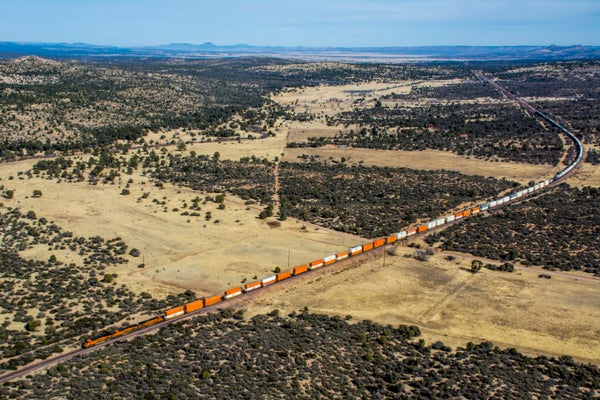The U.S. has no federal limit on freight train length, leaving the cost-conscious rail industry free to experiment with giants like the 3.5-mile, nine-locomotive behemoth that chugged from Texas to California in a 2010 test run. But the question of capping length snapped sharply into focus last year with the fiery crash of a 150-car, 1.75-mile train carrying chemical cargo through East Palestine, Ohio.
Can a train be too long? There are almost no data on any possible dangers posed by multiple-mile freight trains. Now, however, a new study published in Risk Analysis shows that the odds of a train jumping the tracks increases as the vehicle gets longer. Replacing two 50-car trains with one 100-car train raises the aggregate odds of derailment by 11 percent, the study concluded—even accounting for an overall decrease in the number of trains running. A 200-car train would have a 24 percent increase compared with four 50-car trains, according to the study team’s calculations.
The increased risk is relative. “Derailments are uncommon events, fortunately,” says study co-author Peter Madsen, a Brigham Young University professor of organizational behavior. During the decade-long study period, he notes, there were about 300 derailments per year on mainline U.S. railway tracks. With the freight industry’s time and cost pressures likely to continue to mount, safety questions could quickly grow more urgent.
On supporting science journalism
If you're enjoying this article, consider supporting our award-winning journalism by subscribing. By purchasing a subscription you are helping to ensure the future of impactful stories about the discoveries and ideas shaping our world today.
To make their calculations, the study authors needed to know “the base rate of how many trains of different lengths are traveling on different sections of track,” Madsen says. Because those data don’t appear to exist publicly, the team used a method that was previously applied to road vehicle crashes. This technique, known as “quasi-induced exposure,” lets researchers evaluate one type of crash using another type as a baseline. Ideally, comparison events aren’t influenced by the variable in question, so “that group of accidents can act as sort of a proxy” for the missing base rate, he says.
The proxy events used for this study were “beat-the-train” crashes: incidents in which a driver tried a last-minute dash through a crossing ahead of an oncoming train. (The authors assumed that drivers didn’t know, or care, about the length of the oncoming train they failed to beat.) In the absence of better data, this approach gave the authors a window into how long trains tend to get: A U.S. Department of Transportation agency called the Federal Railroad Administration, or FRA, records the lengths of trains involved in derailments, as well as those in beat-the-train accidents. Madsen and the team compared 1,073 of the former to 1,585 of the latter as a control, matched by county and year over the 10-year period.

According to Madsen, this is the first time quasi-induced exposure has been used to analyze train risks. “I hesitate to call it pushing the envelope, but [the study authors] kind of did that,” says Richard Lyles, an emeritus professor of transportation engineering and planning at Michigan State University, who has studied the statistical method. Given that quasi-induced exposure can’t produce the true “derailment rate per train-mile traveled,” Lyles says he would place more emphasis on the study’s general trend than on the specific odds.
After the 2023 derailment in Ohio, Congress requested that the National Academies of Science, Engineering and Medicine (NASEM) form a committee to study trains longer than 7,500 feet (about 1.4 miles). That committee has seen the Risk Analysis study but, through a NASEM transportation board program officer, declined to comment on it. The FRA, meanwhile, is reviewing the paper “to fully understand the methodology used and conclusions drawn,” says the agency’s public affairs deputy director, Warren Flatau.
Jessica Kahanek, assistant vice president of communications at the American Association of Railroads, disputes the study’s risk estimates. “The BYU study fails to take into account the different types of trains or different car types,” she says. “For example, a 50-car train in the study could mean a 2,600-foot coal unit train, 10,000-foot intermodal train or 5,000-foot manifest train.”
Madsen says he and his team are “pretty confident” in their calculations, having controlled for the variables that they could, such as time of day. “I can understand why [industry groups] don’t like the result. And we’re certainly not trying to argue that longer trains should never be allowed,” he says. Long trains can reduce fuel consumption and shrink operational costs, as the study authors note. “We just wanted to add a piece of evidence to the discussion.”
Railroad workers such as Jared Cassity, a former locomotive engineer and chief of safety for the International Association of Sheet Metal, Air, Rail and Transportation Workers Transportation Division (SMART-TD) labor union, are worried about long trains, however. He likens a train to a Slinky toy; there is some slack in a freight train thanks to the coupling devices, nicknamed knuckles, that link each car. Cassity says he is particularly concerned about mixed loads in long trains—when what would have been multiple smaller trains are combined into a single long one—especially if empty cars are placed in front of cars filled with cargo. If moving a uniformly loaded train is like tugging a Slinky across a table, he says, then battling the inertia of a long, heterogenous train can be like trying to control the same spring with a two-pound brick attached to its end.
“We desperately need a law in this country to cap the length of a train,” Cassity says. “We need to know what too long is, and we need to know what the limit is going to be.” The big picture of the Risk Analysis study is correct, in his view: “They’re seeing the reality that long trains derail more often than shorter trains,” Cassity says.
